Are you prepared to advance your knowledge of API testing? We'll cover advanced techniques with Postman, the industry-standard API testing tool, in this guide. Regardless of your level of expertise, these understandings will enable you to confidently take on challenging testing scenarios and much more:
📌 Master Collections and Environments: Structure complex tests and manage variables for different testing stages, including request body and request headers. 🧩
📌 Craft powerful JavaScript test scripts: For response validation, complex logic handling, and repetitive task automation focusing on API testing workflows and Advanced Capability. 🔍
📌 Leverage data-driven testing: With external data sources to create dynamic test cases for thorough coverage. 📊
📌 Utilize mocking and debugging tools: To isolate and troubleshoot API issues with ease. 🔧
📌 Employ Postman functionalities: To test API security vulnerabilities through techniques like authentication testing and authorization checks. 🔒
📌 Collaborate seamlessly: Share Collections, Environments, and test scripts within Postman to work effectively with colleagues. 🤝

What is Postman, and why is it used for API testing?
The task of testing APIs is made easier with the flexible API testing tool Postman. For beginner and seasoned testers as well, it offers a simple interface for generating, organizing, and executing API queries. Testers can send a variety of queries using Postman, such as GET, POST, PUT, DELETE, and more, and carefully examine the answers they receive.
Application Programming Interfaces, or APIs, serve as a bridge between various applications so they can share data and interact. It is important that these APIs operate with no hitch.
Postman streamlines the entire testing process by offering a comprehensive suite of features. Let's delve into some of Postman's powerhouses that make API testing efficient and effortless.
Postman's Powerhouse Features for Effortless API Testing:
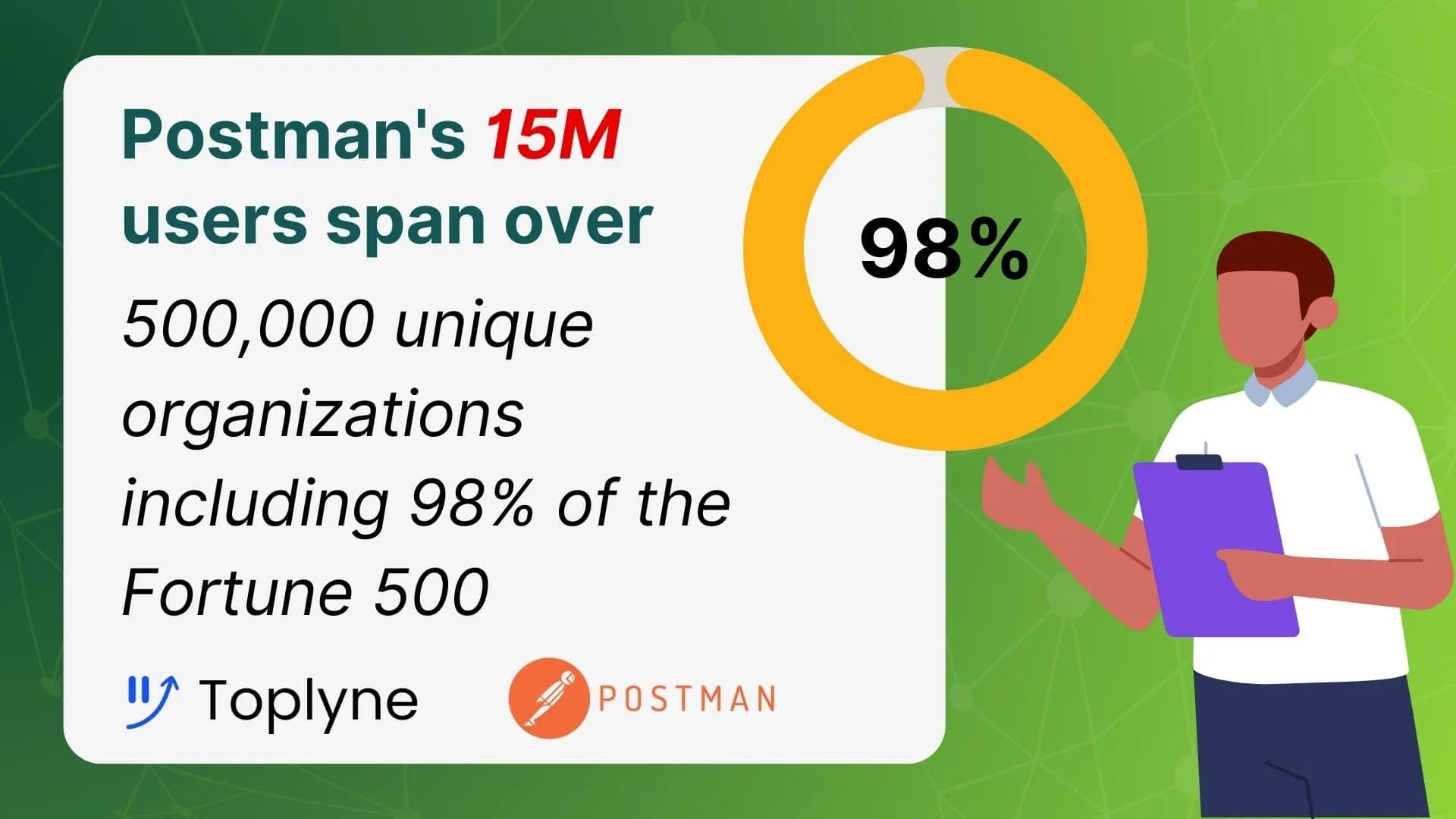
Why is Postman best for API testing?
Postman is the tool of choice for API testing for a variety of reasons:

📍User-Friendly Interface: Making and running API queries without writing complicated code is made straightforward by Postman's user-friendly interface.
📍Teamwork: Postman allows collection sharing, testing workflow collaboration, and testing process streamlining.
📍Automation: Postman offers script-based automation capacity, enabling testers to efficiently carry out regression testing by automating time-consuming operations using automation techniques.
📍Rich Features: Postman offers numerous features that improve the testing experience, such as integrations with other tools, mock servers, environment variables, and test assertions.

Example:
Imagine you're a web developer adding weather updates to a client's site using the OpenWeatherMap API. You choose Postman for testing because:
- Easy to Use: With Postman, you can request weather data for different places without coding, including specifying data in the request body.
- Collaboration: You share your test setup with the client so they can see and comment on it.
- Automation: Postman can automatically check weather data regularly once the site is live, utilizing automation techniques.
- Accuracy Checks: You can set up tests to ensure the weather data matches expectations, including validating response codes.
- Monitoring: Postman helps you keep an eye on the weather API's performance over time, including response time. By using Postman, you ensure the weather updates work smoothly and accurately for your client's website.
Speed up your API Tests using the Advanced features of Postman.
You can accelerate your API testing process by using Postman's advanced features as you gain more experience with it. The following strategies will help you test more effectively:
- Environment Variables: To make handling test data and configurations across several contexts easier, use environment variables. 🚀
- Collections and Folder Structure: To maintain a structured testing framework and enhance readability, group your API inquiries into collections and folders, utilizing separate collections for different functionalities 📂
- Prerequisite and Test Scripts: Automate tedious operations, handle request data, and verify responses by employing prerequisite and test scripts, focusing on writing tests effectively. 🔧
- Request Chaining: To test end-to-end scenarios and imitate intricate API workflows, chain together several requests, simulating realistic API testing workflows. 🔗

Explore Postman’s Advanced Techniques for API Testing.
Postman offers a wide array of advanced techniques to elevate your API testing process. Let's delve deeper into some key strategies:
- JavaScript Scripting: Write custom scripts to automate tasks and manipulate data dynamically, including request body construction and response validation.
- Pre/Post-request Scripts: Execute code before sending requests or after receiving responses for setup and validation, using test scripts for improved test maintainability.
- Environment Variables and Data Files: Parameterize tests with environment variables and iterate over data sets from files, including external data sources.
- Assertions and Test Suites: Validate responses with assertions, focusing on response codes, response body content, and header validation, and organize tests into suites for better management.
- Collection Runner and Newman Integration: Run collections sequentially or concurrently with the Collection Runner or integrate with Newman for command-line execution and CI/CD pipelines.
- Mock Servers and API Monitoring: Simulate API endpoints with mock servers to isolate and test external services, and monitor API performance and reliability in real-time, including response time monitoring.
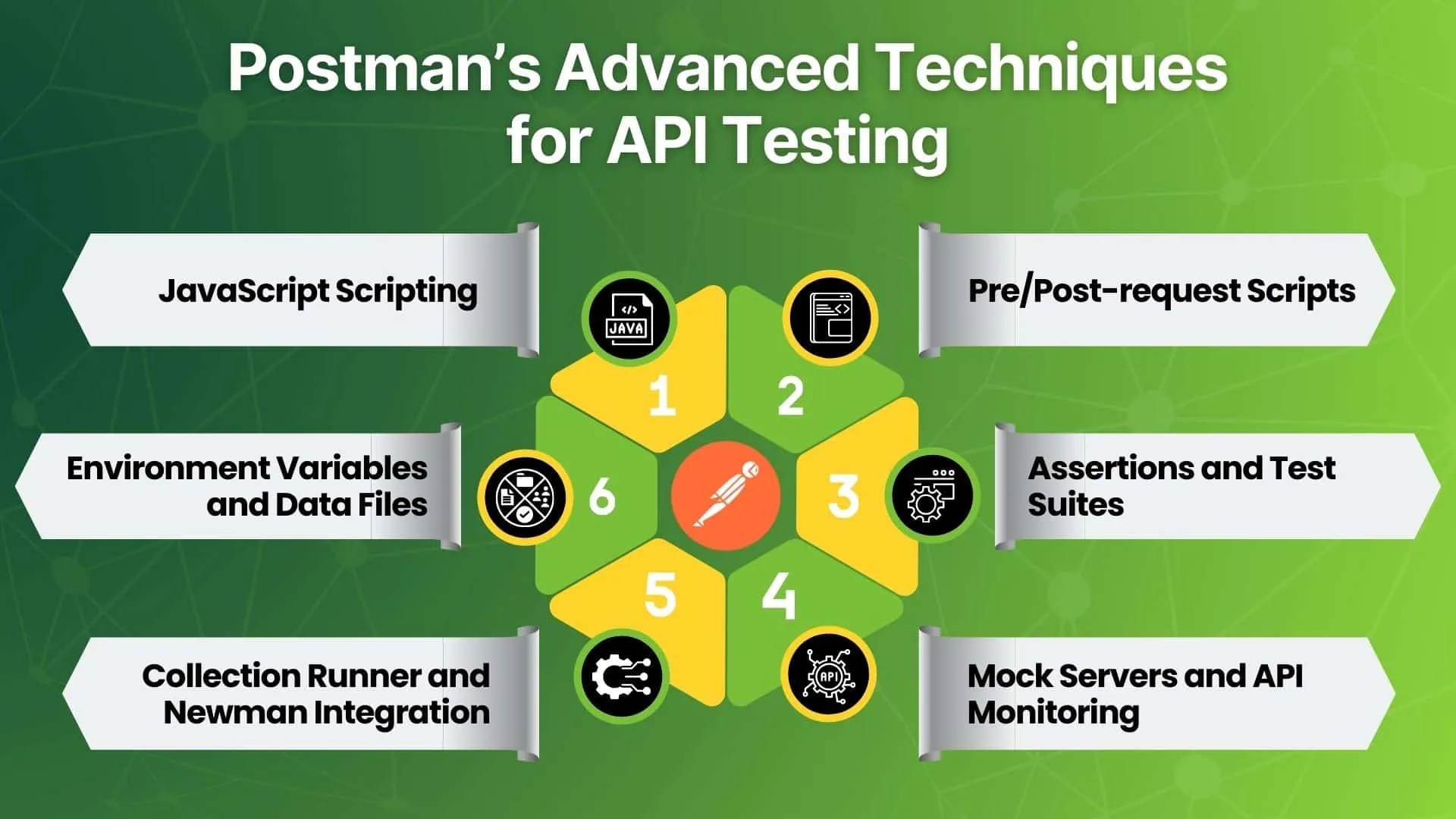
Common Challenges Faced with Postman
Despite its versatility, Postman users may encounter some challenges during API testing. Here are some common issues and how to address them:
🟢Handling Authentication: Testing APIs that require authentication can be challenging, especially when dealing with tokens or OAuth. Ensure you correctly set up authentication methods in Postman and handle token expiration gracefully.
🟢Managing Environment Variables: While environment variables in Postman are powerful, managing them across different environments can become cumbersome. Keep your variable names and scopes consistent, and consider using scripts to automate environment setup.
🟢Dealing with Dynamic Data: APIs often return dynamic data such as timestamps or unique identifiers, making it challenging to create stable tests. Use Postman's scripting capabilities to generate dynamic data in the request body or extract values from responses dynamically.
🟢Maintaining Test Suites: As your test suite grows, maintaining and organizing collections and requests can become challenging. Regularly review and refactor your test suite, utilize folders and naming conventions effectively, and consider using version control systems like Git to track changes and revert to previous versions if necessary.
🟢Handling Dependencies: Testing APIs with dependencies on external systems or services can be tricky. Mock external dependencies where possible, or use Postman's mock servers to simulate responses and reduce dependency on external systems during testing.
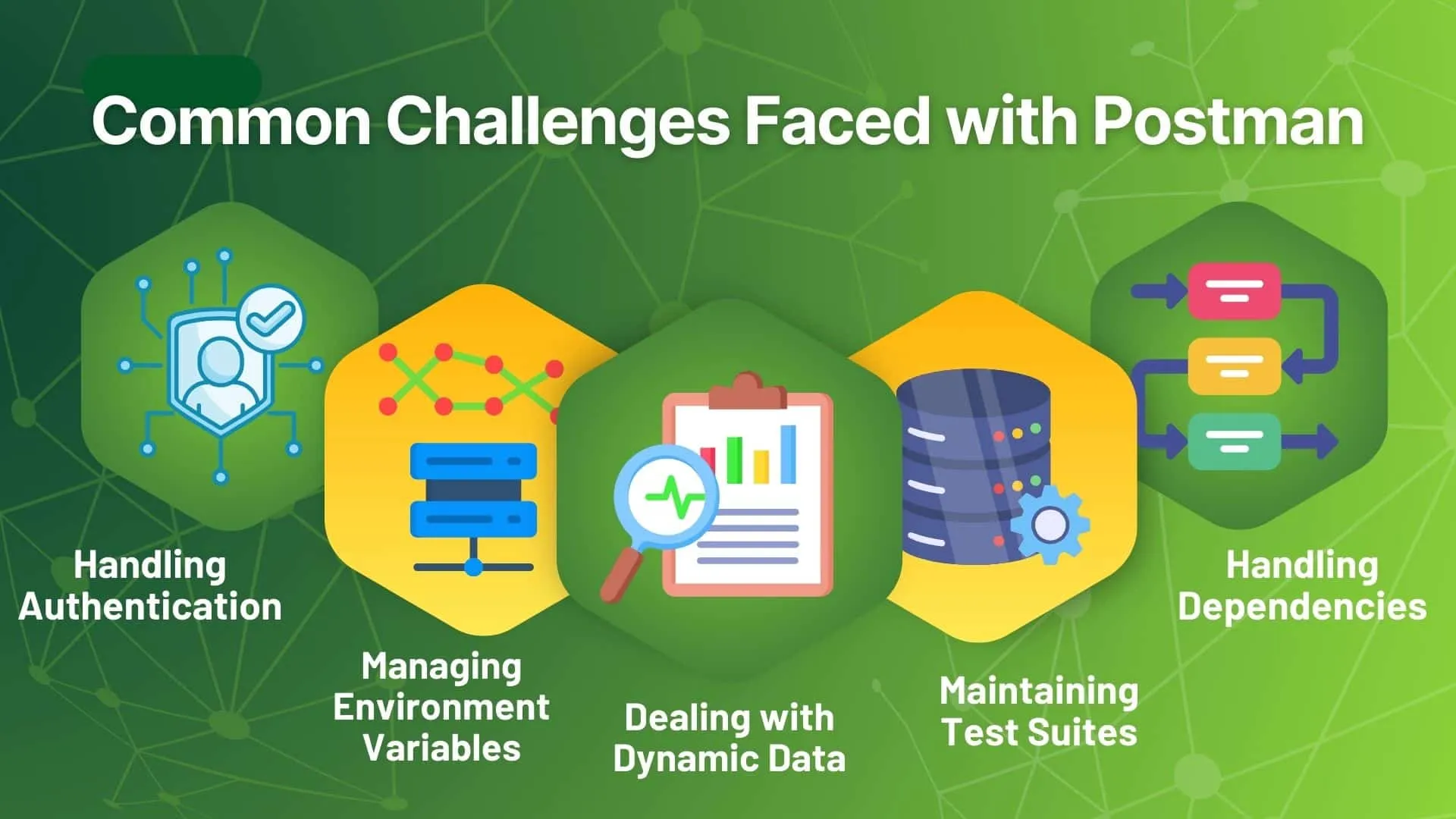
Advanced Assertion Techniques for validating complex API responses in Postman
Postman offers various assertion capabilities to validate API responses against expected outcomes. Beyond simple status code and response body checks, you can employ advanced assertion techniques such as:
- Structure Validation: JSON Schema validation checks the structure and data types of the response payload to ensure API answers follow a preset model. As an illustration, you may develop a JSON schema to verify the response's layout for a user profile, including validating specific data types in the request body.

- Dynamic Variables: Postman allows you to use dynamic variables in assertions, enabling flexible and reusable tests. For example, you can use the response data from one request (e.g., a user ID) in assertions of subsequent requests, improving test maintainability.
- Custom JavaScript Assertions: With Postman's scripting capabilities, you can write custom JavaScript functions to perform complex validation logic. For instance, you can parse nested JSON objects, validate specific data conditions, or calculate derived values based on the response, focusing on intricate response structures.

These advanced assertion techniques allow you to ensure the integrity and correctness of API responses, even in complex scenarios.

Techniques we can use in Postman to replicate different response situations
Postman provides features to simulate various response situations, allowing you to test your application's behavior under different conditions:
- Mock Servers: Postman's mock servers enable you to simulate API responses without actual backend implementation. Mock endpoints can be made to provide pre-programmed results, such as success, error, or timeout messages, simulating potential issues. This allows you to test your application's resilience to errors.
- Delay and Timeout Settings: You can check the resilience of your application by simulating network lag and timeouts by establishing delay and timeout settings in requests. To see if your application responds to a sluggish server response appropriately. For example, you can simulate response time problems by adding a 5-second delay to the answer by displaying a loading indication.
- Dynamic Data Generation: Postman's scripting capabilities allow you to generate dynamic data to simulate real-world scenarios in the request body. For instance, you can use scripts to generate random user IDs, timestamps, or unique identifiers in responses. This helps in testing scenarios where the API returns dynamic data, ensuring your tests are robust and adaptable to varying conditions.
These techniques enable comprehensive testing of your application's behavior under diverse response situations, ensuring its reliability and performance in production environments.
Example :
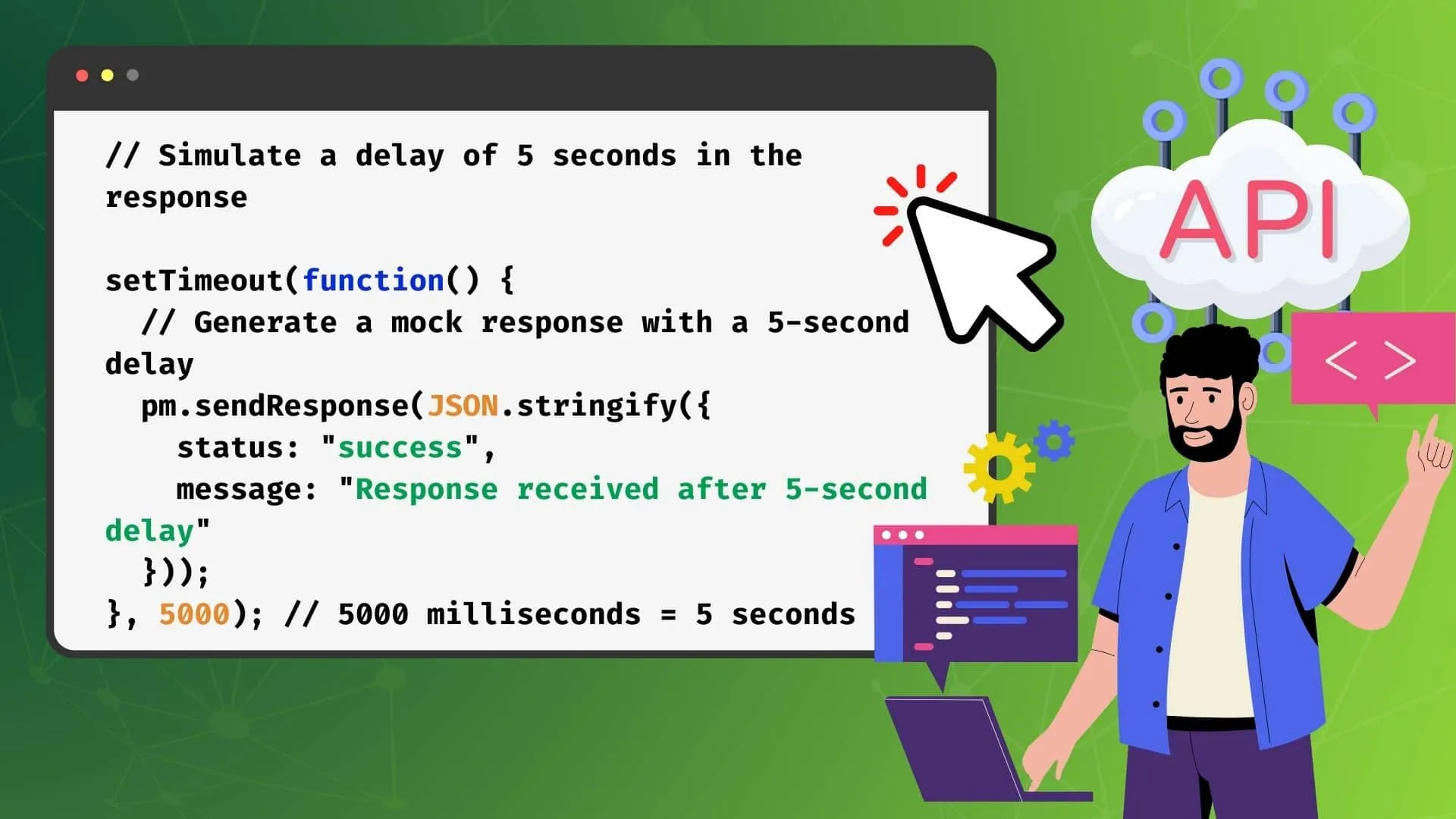
Use Postman's scripting features to do Advanced API testing.
Postman's scripting capabilities empower testers to perform advanced API testing scenarios using JavaScript. Here are some ways to leverage scripting in Postman:
📍Pre-request Scripts: Use pre-request scripts to dynamically generate request data (e.g., in the request body ), set headers, or perform authentication before sending requests, streamlining the testing process.
📍Test Scripts: Write test scripts to validate API responses, extract data from responses for further assertions, and perform custom assertions using JavaScript, focusing on writing effective tests.
📍Automation: Automate repetitive tasks and complex testing workflows using Postman's scripting capabilities, saving time and effort in the testing process. This can include automating test suites for regression testing or data-driven testing.
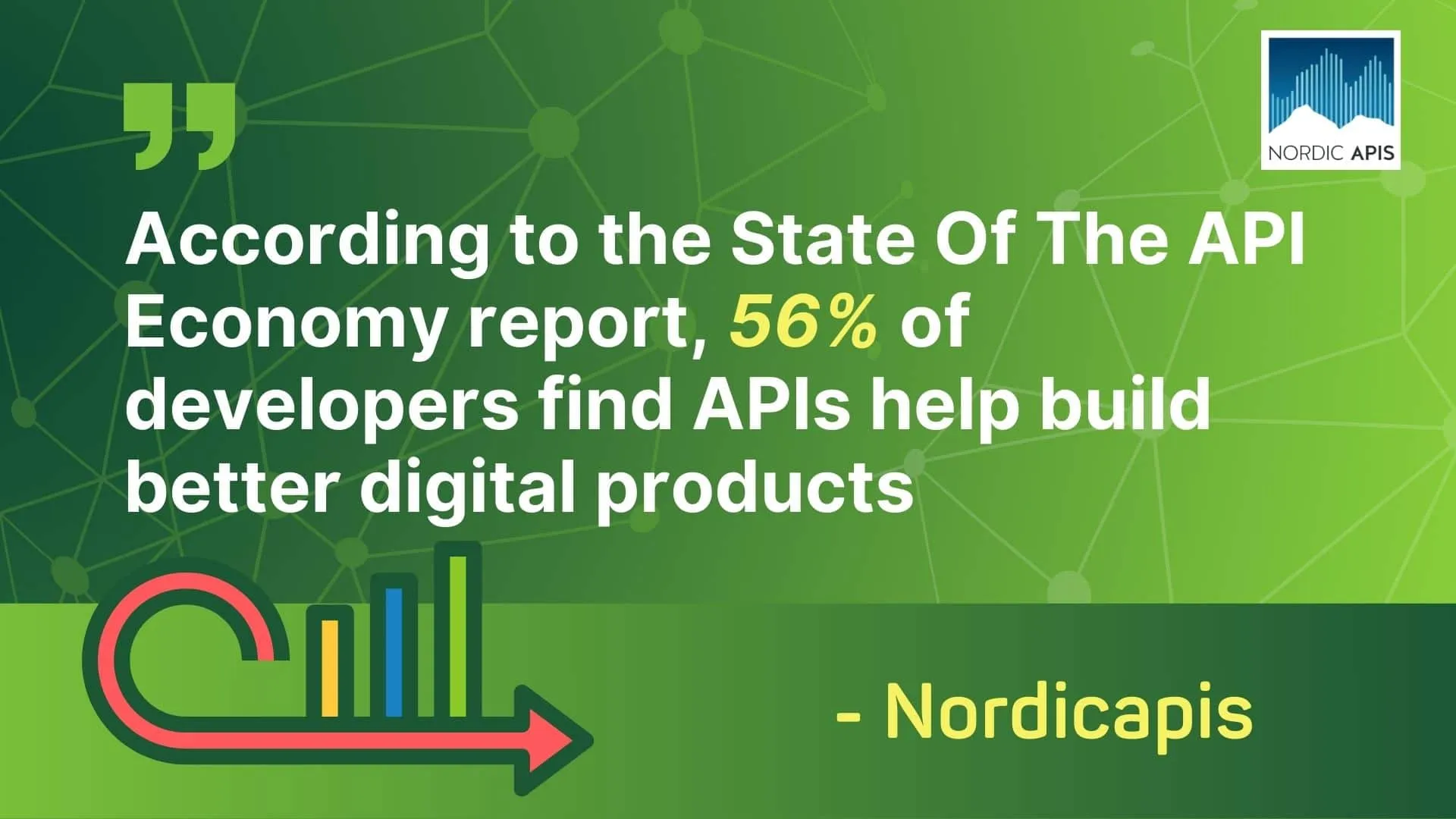
The key role environments and variables play in Advanced Postman API testing
Environments and variables play a crucial role in advanced Postman API testing by providing a flexible and configurable testing environment. Here's how environments and variables can enhance your testing workflow:
🟢Environment Management: Define multiple environments (e.g., development, staging, production) in Postman to test your API across different environments seamlessly. This is particularly important in modern software development where environments may have different configurations.
🟢Environment Variables: Use environment variables to store dynamic values like API endpoints ( endpoint URLs ), authentication tokens, test data, and other configurations in the request body, making your tests more portable and maintainable across different environments.
🟢Variable Scope: Understand the scope of variables in Postman (e.g., global, environment, local) and use them appropriately to control variable visibility and prevent conflicts. This is especially important as your test suites become more complex.
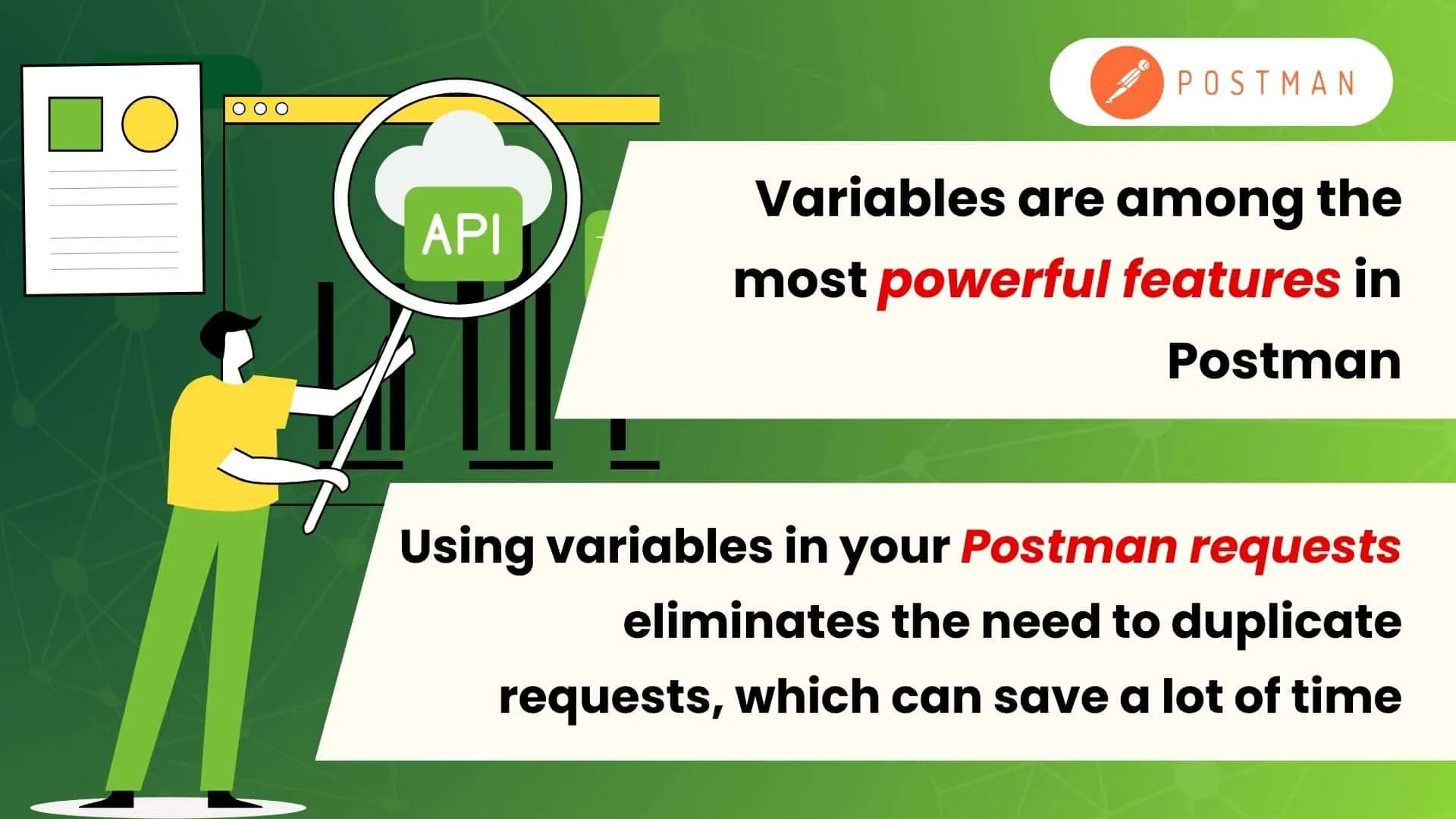
The best practices for writing and organizing tests in Postman to ensure robust API validation
To guarantee strong API validation in Postman, adhere to the following recommended techniques when crafting and structuring tests:
📍Clear Documentation: To ensure transparency and clarity, make sure that your API tests are well documented. This includes the test objectives, input data (including request body ), expected outcomes, and test results.
📍Environment Management: To test your API consistently across multiple scenarios, define several environments (such as development, staging, and production) in Postman, as discussed previously.
📍Environmental Factors: To make your tests more portable and manageable, use environment variables to hold dynamic benefits like test data, authentication tokens, and API URLs, including data used in the request body.
📍Variable Scope: Utilize Postman's variables (such as global, environment, and local variables) wisely to handle their visibility and prevent conflicts, as discussed previously.
📍Modularization: To increase readability, maintainability, and reusability, break large tests into smaller, modular tests focusing on specific functionalities or API endpoints. This improves code maintainability and allows for easier debugging.
📍Consistent Naming conventions: To preserve an identical testing framework and promote cooperation, establish consistent naming standards for requests, folders, and variables. This improves code readability and collaboration among testers.
📍Version Control: For communicating with team members, keep track of changes made to your Postman collections and environments, and roll back to earlier versions when necessary, using version control systems like Git. This is crucial for managing changes to API tests as the API itself evolves throughout the development lifecycle.

Types of API Testing Methods
Understanding the different types of API testing methods is essential for comprehensive API test coverage. Here are some common API testing techniques:
📍Unit Testing: Test individual components or functions of the API in isolation to verify their correctness and functionality.
📍Integration testing: Verify efficient integration and communication by looking at how various API modules or components interact with one another, focusing on API workflows.
📍Functional Testing: Examine different endpoints, input combinations (including data in the request body ), and anticipated results to verify that the API functions as intended. This ensures the API fulfills its designed purpose.
📍Performance testing: To find performance bottlenecks and optimize resource utilization, assess the API's performance under various load scenarios, such as many users or high traffic volumes. This helps identify potential issues that may arise in production.
📍Security Testing: Assess the security posture of the API by testing for vulnerabilities, such as injection attacks, authentication flaws, or sensitive data exposure in the response body. This is crucial to ensure the overall security of your application.

Tips for Organizing and maintaining large collections and Environments in Postman
Managing large collections and environments in Postman can be challenging without proper organization. Here are some tips to help you organize and maintain your collections and environments effectively:
📍Use Folders and Subfolders: To keep your requests organized logically, divide them into folders and subfolders that correspond to functional areas, endpoints, or modules. This improves the organization and findability of tests.
📍Naming Guidelines: For simpler access and search, use standard naming norms for requests, variables, and folders. This improves code readability and maintainability.
📍Versioning: Implement versioning for your collections and environments to track changes and ensure compatibility with evolving APIs and application versions. This is especially important throughout the development lifecycle as the API and tests may change.
📍Documentation: Document your collections and environments with descriptions, examples, and usage guidelines to onboard new team members and ensure knowledge sharing. This improves collaboration and reduces onboarding time.

Conclusion
Mastering advanced API testing with Postman is crucial for efficient development. With features like environment control and scripting, testers can streamline their work and detect issues faster.
Organizing tests with folders and clear naming helps manage projects effectively. Though Postman is excellent, considering other tools is wise. By using Postman effectively, testers ensure reliable, secure APIs, making development more efficient.
People also ask
👉🏻Is Postman the best API tool?
Given its function-rich feature set, simplicity of use, and dependable testing capabilities, Postman is regarded as one of the top tools for API testing. However, other tools may be better suited for specific needs.
👉🏻What are the different options for running collections in Postman?
Postman offers multiple options for running collections, including single-request execution, Collection Runner Newman command-line tool, and integrating with continuous integration (CI) platforms like Jenkins.
👉🏻What scripting languages are supported by Postman, and which is best suited for API testing?
JavaScript is supported with Postman for scripting, and because of its familiarity, flexibility, and large libraries for modifying data and making HTTP queries, it's an excellent choice for testing APIs☯
👉🏻How can we use Postman's request connecting feature to test practical API workflows?
Postman's request chaining feature allows you to connect multiple requests together, simulating practical API workflows such as authentication, data retrieval, and validation, in a single test scenario. This allows for more realistic testing of API interactions.
👉🏻How can we leverage Postman for the security testing of APIs?
In order to evaluate the security posture of APIs and find vulnerabilities, Postman provides security testing features including request authentication, SSL certificate verification, and interaction with security testing instruments like OWASP ZAP. This is crucial to ensure the overall security of your application.





%201.webp)

